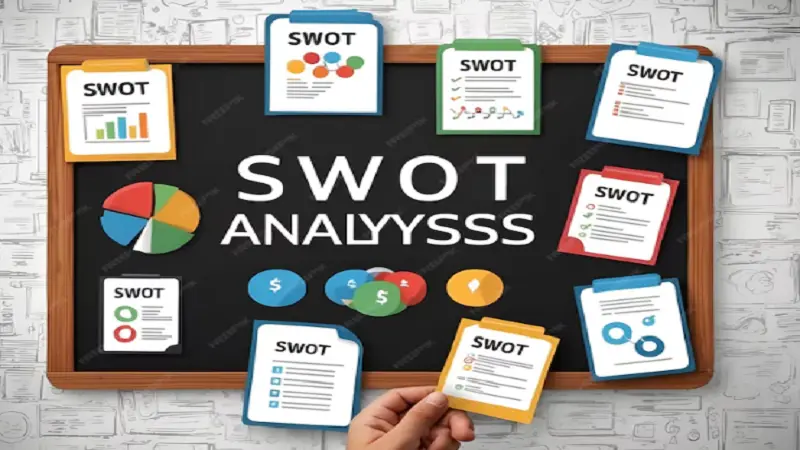In today’s fast-paced and competitive market, small businesses and startups must navigate challenges with strategic foresight. One essential tool for understanding a business’s current standing and planning for the future is the SWOT analysis. SWOT stands for Strengths, Weaknesses, Opportunities, and Threats, providing a structured method for evaluating both internal and external factors that can influence business success.
This guide will take you step-by-step through conducting a SWOT analysis tailored to small businesses, offering practical tips and real-world examples to help you begin.
1. Understanding SWOT Analysis
SWOT analysis is a strategic tool that enables businesses to assess their internal strengths and weaknesses alongside external opportunities and threats. For small business owners, this analysis can provide a clearer perspective on their current position, helping them make informed decisions to enhance competitiveness and drive growth.
2. Importance of SWOT Analysis for Small Businesses
For small businesses, conducting a SWOT analysis is vital for several reasons:
- Strategic Planning: It aids in setting achievable goals and devising strategies to reach them.
- Resource Management: Identifying strengths and weaknesses allows for more efficient resource allocation.
- Risk Mitigation: Understanding potential threats helps in developing contingency plans.
- Opportunity Exploration: Spotting external opportunities can pave the way for new growth avenues.
3. Steps to Conduct a SWOT Analysis
Here’s how to carry out a SWOT analysis effectively:
Step 1: Gather Relevant Information
Begin by collecting data related to your business operations, market trends, competition, and customer feedback. This data will form the basis of your analysis.
Step 2: Identify Strengths
Evaluate what your business does well. These strengths are internal, such as:
- Unique Offerings: Products or services that differentiate you from competitors.
- Brand Reputation: A strong and trusted brand presence.
- Customer Loyalty: A dedicated customer base that consistently supports your business.
Step 3: Identify Weaknesses
Next, assess areas where your business could improve. These weaknesses are also internal, such as:
- Limited Resources: Fewer financial or human resources than larger competitors.
- Skill Gaps: Areas where your team lacks expertise.
- Inefficient Processes: Outdated or cumbersome business processes that impede growth.
Step 4: Identify Opportunities
Opportunities are external factors your business can leverage, such as:
- Market Trends: Emerging trends that align with your offerings.
- Technological Innovations: New technologies that could enhance your operations or products.
- Expanding Markets: Opportunities to enter new geographic or demographic markets.
Step 5: Identify Threats
Finally, consider external risks that could negatively impact your business, such as:
- Economic Downturns: Economic challenges that could reduce consumer spending.
- Increased Competition: New or existing competitors threaten your market share.
- Regulatory Changes: New laws or regulations that could affect your operations.
4. Developing a SWOT Matrix
After identifying your strengths, weaknesses, opportunities, and threats, organize them into a SWOT matrix. This matrix helps you visualize the relationships between these factors and create strategies to leverage strengths, mitigate weaknesses, seize opportunities, and defend against threats.
- Strengths/Opportunities: How can your strengths help you capitalize on opportunities?
- Strengths/Threats: How can your strengths be used to counteract threats?
- Weaknesses/Opportunities: How can you improve weaknesses to take advantage of opportunities?
- Weaknesses/Threats: How can you address weaknesses to protect against threats?
5. Practical Examples of SWOT Analysis
To illustrate, here are a few examples of how small businesses might use a SWOT analysis:
Example 1: A Local Coffee Shop
- Strengths: High-quality coffee, loyal customer base, prime location.
- Weaknesses: Limited marketing budget, no online presence.
- Opportunities: Growing trend of supporting local businesses, potential for online sales expansion.
- Threats: Competition from larger chains, increasing rent costs.
Example 2: A Tech Startup
- Strengths: Innovative product, skilled technical team.
- Weaknesses: Limited funding, and lack of brand recognition.
- Opportunities: Rising demand for tech solutions, potential for strategic partnerships.
- Threats: Rapid technological shifts, and emerging competitors.
6. Utilizing a SWOT Analysis Template
To streamline the process, you can use a SWOT analysis template. A template will guide you through each step and ensure that no critical factor is overlooked. This is particularly useful for small business owners conducting a SWOT analysis for the first time.
7. Conclusion
Conducting a SWOT analysis is a valuable exercise for any small business. By thoroughly assessing your business’s strengths, weaknesses, opportunities, and threats, you can develop strategies to achieve your goals and navigate challenges more effectively. Whether you’re just starting or managing an established business, regularly revisiting your SWOT analysis can keep you on track and help you stay competitive in a rapidly evolving market.
